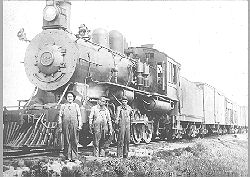
Full Size = 51K

As the tangled affairs of this latter railway proved to be the key which opened the door for the vast migration to the prairies, it is necessary to deal with it in some detail.
From 1885 onward, the Temperance Colony at Saskatoon which had to freight all its supplies from Regina and Moose Jaw by team, together with Prince Albert, one of the oldest communities in the west were clamoring for rail connection with the C.P.R. main line at Regina. Finally, through the efforts of a prominent Winnipeg financial concern, Messrs. Osler, Ammond and Nanton, a company with the grandiose name of "The Qu'Appelle, Long Lake and Saskatchewan Railroad and Steamboat Company", was organized to build the railway. The necessary capital was raised from English sources and construction started in 1889.
The steel reached Saskatoon in July, 1890, and was completed to Prince Albert later the same year. In keeping with the policy of the time covering railway construction, the company received from the Dominion Government a grant of land totaling 1,600,000 acres adjoining the railway right of way. When completed the road was operated by the C.P.R. under a lease agreement to run ten years.
From 1890 to 1900, the owners made little attempt to obtain settlers for the land covered by the grant, consequently little freight traffic was developed, resulting in poor returns on the investment. This situation led to dilatory tactics on the part of the company in the selection of their land, claiming that it was unsuitable for agriculture and demanding additional land in other areas from which to make their selection. They even went so far as to threaten legal action against the Government. At this stage, early in 1902, two Canadians appeared on the scene, Messrs. Davidson and McRae, of Winnipeg and Minneapolis, who had been very successful in disposing of Great Northern Railway land in the states of Minnesota and North Dakota for the railway magnate, James J. Hill of St. Paul. Getting wind of the state of affairs between the Dominion Government and the Qu'Appelle, Long Lake and Saskatchewan Railroad and Steamboat Company, Davidson and McRae approached the disputants with an offer for the land. The offer was accepted by both parties and resulted in the purchase of all the unselected land remaining in the original grant, amounting to almost 1,000,000 acres, for the price of approximately $1.25 per acre.
This deal had far reaching effects on Western Canada as a whole, and on the Saskatchewan Valley in particular.
Firstly, it started the greatest migration of people ever to take place on the North American continent. It led to the Saskatchewan Valley, of which Humboldt is a part, being settled by people of predominantly American origin. Thirdly, it produced the only mass emigration in the entire history of the United States. According to figures of the Dominion Bureau of Statistics, in the ten year period 1901 to 1911 three quarters of a million people entered and settled in the provinces of Saskatchewan and Alberta.
Not all of these were Americans. Eastern Canada, the British Isles.
The history of this land deal would not be complete without a recounting of the story of the Meillike wheat field which had wide publicity at the time.
A prominent American, Mr. E. J. Meillike, was a jump ahead of Davidson and McRae by a purchase in 1901 of considerable acreage at Dundurn from the Saskatoon Temperance Colony. In the spring of 1902 he seeded a large field of wheat on spring breaking. In July, when the Davidson and McRae train reached Dundurn they saw a magnificent field of wheat waving in the summer breeze which to them was convincing proof that the land was suitable for growing wheat. It was later claimed that, as a result of seeing Meillike's wheat field, many who had purchased limited acreages doubled or tripled their purchase, while others who up to this time were doubtful, made extensive purchases. This incident grew into the legend that "Meillike's wheat field settled the whole of the Saskatchewan Valley."
In the Humboldt district, however, a religious organization, the Order of St. Benedict, became the agency of settlement having obtained the colonization rights covering about fifty townships extending from Engelfeld on the east to Prud'homme on the west. The purpose of the Order was to establish the Colony of St. Peters by settling people of their religious faith, as far as possible, on the land. The head of the Order and founder of the Colony was the late Right Rev. Abbot Bruno, O.S.B., and the success of the undertaking is shown in the thriving parishes of Humboldt, Carmel, Bruno, Dana, Peterson, Cudworth, St. Benedict, Leofeld, Hoodoo, Willmont, Fulda, Pilger, Lake Lenore, Annaheim, St. Gregor, Muenster, and a number of other parishes; the prosperous farms of the district; the splendid Cathedral and College at Muenster now catering to the educational and cultural needs of the people.
There are some Humboldt Journal Articles pertaining to this topic:
 Huge Land Deal Being Consummated
Huge Land Deal Being Consummated
 50,000 Acres To Change Hands In The Humboldt District
50,000 Acres To Change Hands In The Humboldt District
There are also some Down Memory Lanes pertaining to this topic:
 Early Business Community
Early Business Community
[ Home ]
Please send comments to Carlton Trail REDA Inc.
![]()
[ The Humboldt Journal ]
[Early Humboldt]
[ St. Peter's Abbey | Agriculture | Communities ]
[ Present-day Humboldt and Surrounding Communities ]
[ Language ]
![]()